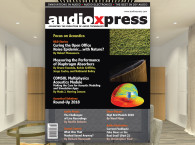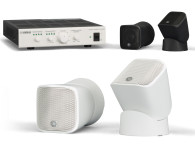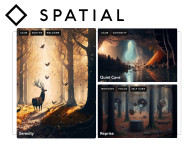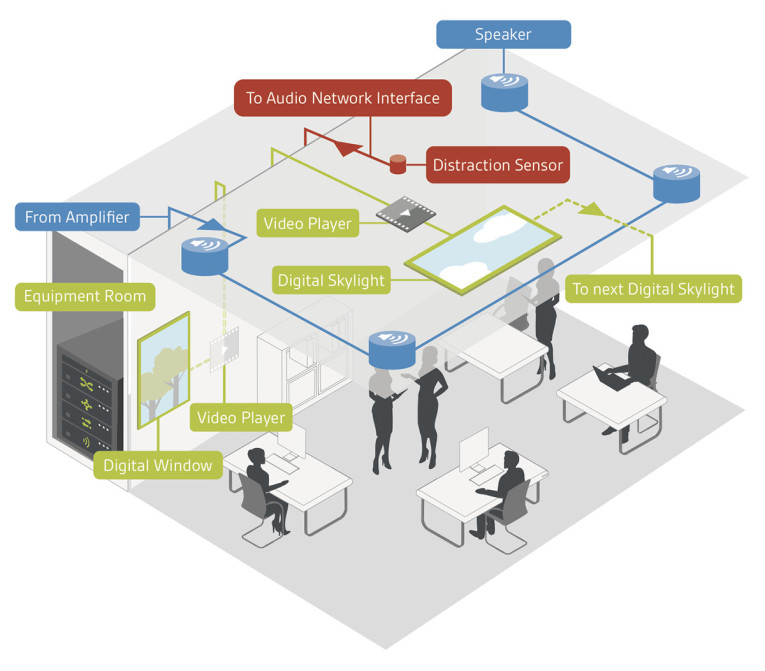
Open offices with beautiful designs are making headlines around the globe. However, the human experience within those open offices can often be overlooked, especially when it comes to how those offices sound. Plantronics moved its Santa Cruz, CA, headquarters to an open plan office a few years back, and employees immediately began feeling distracted by noise.
In our quest to solve the noise problem in the open office for ourselves, we developed a unique, industry-first solution called Habitat Soundscaping. Habitat Soundscaping, which Plantronics announced in July of 2017, combines nature-inspired audio and visual elements to engage and immerse people with both sight and sound. Coupled with room-based, intelligent software, it actively works to mitigate distracting noise (see Figure 1).
On Nature’s Path
The journey to get there was not what we expected. As technologists, we arrive at solutions to our customers’ problems through rounds of research, big sky thinking, prototyping, and testing until we get it right. After years of developing services for enterprise communications, we believe in what we call a Smarter Working approach that puts people first by recognizing, accommodating, and nurturing their various work styles—whenever and wherever they work. Smarter Working not only informs the products and services we create but is a philosophy that we practice in our own work environment.
We knew our background in acoustic technology and Smarter Working would help us address distracting noise in our office. But what we didn’t know is that we’d be traveling down nature’s path to get there.

A Case for Biophilic Design
Our research continued to show that access to nature can help sharpen thinking, restore energy, and help reduce stress. As human beings, we have an innate desire to connect with nature, yet we’re inside most of the time. According to the US Environmental Protection Agency (EPA), the average American spends 87% of the day indoors and nearly as much time in the car (6%) as outside (7%). It became clear that nature in some form was going to be an integral part of our solution.
We found that a key ingredient for curing open office noise is related to biophilia. I have no doubt when you read the words “biophilia” or “biophilic science” you might think I’ve just shared a bit too much about my medical history! But despite its somewhat medical-sounding name, biophilic design is a design principle that incorporates the benefits between nature and humans into the built environment. According to a report by Human Spaces, introducing biophilic elements to an office environment can help induce powerful benefits, such as:
• 15% increase in well-being
• Up to 6% increase in work productivity
• 15% increase in creativity
Research has proven natural water sounds are the most effective means to reduce the impact of intelligible speech while also creating a comfortable, rejuvenating environment for work. Imagine the sounds of a gentle waterfall or a babbling brook.
Research also shows that bringing visual connections to nature into the office can improve cognitive functioning and increase well-being. Think images of birds, creeks, waterfalls in digital form or in-office water walls. In our Habitat Soundscaping solution, nature-based visuals complement the nature inspired audio to create a harmonious, multisensory experience (see Photo 1).

Introducing Intelligent Software to the Solution
By combining biophilic elements, specifically the sights and sounds of nature, with highly sophisticated, adaptive, and data-driven acoustic software, you end up with a solution that ensures distracting intelligible speech is dramatically reduced. This results in a peaceful, welcoming environment where focus work and collaboration can happen in the same place, at the same time and where employees can thrive (see Photo 2).
We’ve incorporated software into our Habitat Soundscaping solution using complex algorithms to continuously respond to changing levels of distracting conversation. We recently added realtime visualizations of office acoustics to show noise levels, distracting conversation levels, and how the Habitat Soundscaping system is responding to distracting levels of conversation. It’s a huge difference when compared to filtered noise, which are known to trigger health issues such as headaches and fatigue.
Although I’m sure we’d all agree that companies that create open work spaces do so with the best of intentions, but visually stunning designs with open floor plans and challenging acoustics can very often lead to unhappy, and even absent employees.
According to a Gensler workplace survey, over half the employees working in open offices are disrupted by others when trying to focus. And for the employees who do come into the office, a study by the University of California, Irvine shows each interruption costs employees an average of 23 minutes to get back on track.
A noisy work environment can even impact the war for talent. A 2018 Plantronics study with Oxford Economics found that millennials are particularly annoyed by office noise and that people in the noisiest offices are most likely to say they’ll leave their job in the next six months. This is vital data for Human Resources departments since according to a report by Human Spaces, one-third of office workers say the design of an office impacts their decision to work at a company.
We’re excited to be the first company with an offering that ensures organizations no longer have to choose between having a beautiful, modern open office or a peaceful, calm and collaborative workplace. Our hope is that this solution will help companies create productive environments that also support employee wellness. In October 2017, Frost & Sullivan honored Plantronics with the 2017 North American Augmented Reality Technology Innovation Award for Habitat Soundscaping. In the related award report, Frost & Sullivan notes, “Plantronics has identified a significant business problem and then applied cutting-edge technology to address that problem. Its Habitat Soundscaping service allows businesses to reap the rewards of open office spaces while minimizing the problems associated with them.”
Habitat Soundscaping was also recently recognized at Integrated Systems Europe (ISE), winning the 2018 Top New Technology Award in the Audio Distribution Systems category. The service was also recently named a finalist for the Best of Enterprise Connect Award 2018.
A Deeper Look at the Habitat Soundscaping System
Now it’s time to get under the hood of our system. Habitat Soundscaping consists of core elements that make up our holistic approach to managing noisy distractions within the office. Those elements include sights, sounds, intelligence, and a cloud-based subscription.
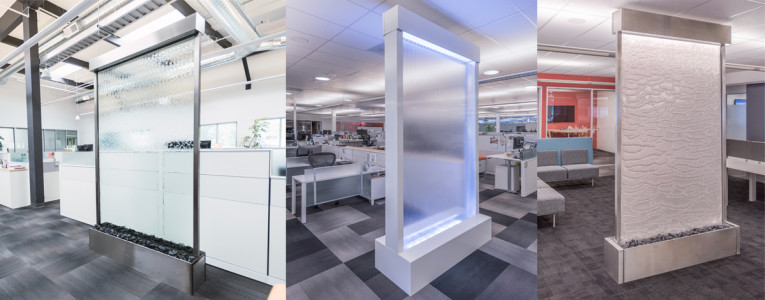
Sounds
Soothing sounds of nature create a harmonious environment that boost overall wellness and leave people feeling creative and energized. We built our audio from the ground up by heading into the outdoors and recording water sounds at various running streams. To make sure we had the audio right, we then compared the water sounds we recorded to a sound template we tested as being effective at reducing intelligible speech.
We tuned the water sounds to provide more energy in the frequencies important to speech intelligibility (1 kHz to 4 kHz), then ran the sound over high-pass filters to cut out low-frequency artefacts. Our audio tracks are precisely engineered to match the visual displays of the system so that it delivers a realistic natural experience.
This audio is carried through in-ceiling speakers that dynamically adjust to changing conversation levels, which are strategically placed throughout a workspace. In-ceiling sensors detect distracting speech, quantify its distractive power, and dynamically adjust speaker volume in surrounding areas.
Although acoustic treatment can help — we’ve designed the system to work in any variety of open office environments with varying acoustic parameters. These can include open ceilings, different acoustic presence of acoustic wall panels, type of carpet, and varying cubicle partition heights.

Sights
Real water features complement the nature-inspired audio tracks and provide the innately soothing presence of running water. We offer three unique waterfall designs to augment a work space based on needs (see Photo 3). Each waterfall comes in three different dimensions (8’ × 4’, 9’ × 5’ and 10’ × 5’) and includes a two-year limited warranty.
An open mesh waterfall allows water to flow over a woven stainless-steel mesh surface. The result is remarkable cascading wave patterns, which makes this a beautiful addition to any space. This offering includes a ultraviolet (UV) sterilizer and reverse osmosis filter. For a relatively easy water feature to install and maintain, we also offer an enclosed waterfall. In this feature, water flows between two sheets of acrylic, adding movement and energy to a static space. Our third option is an open waterfall where water flows down a single, clear sheet of glass and creates a visually stunning water feature. This last version also comes with a UV sterilizer and reverse osmosis filter.
If a water feature is not the right fit, the Habitat Soundscaping solution also has the option to use virtual displays of serene landscapes including babbling brooks in wooded settings. These displays integrate with natural sounds to deliver a rich, multisensory experience. Displays include ceiling-mounted flat panel monitors that show natural scenes and flat panel displays designed to look like conventional windows. Each window provides a natural vista, bringing light and an inspiring view of nature into the office (see Photo 4).
Intelligence
Intelligent software acts as the central hub for the Habitat Soundscaping service. Complex algorithms continuously monitor distraction sensors and adjust speakers to seamlessly maintain perfect, natural harmony within the space. The software’s user interface gives users the ability to change a theme, toggle Adaptive Soundscaping Intelligence, control or mute the volume, view audio zones overlaid on floor plans, adjust scheduling and set the health check feature (see Photo 5). And the recently released acoustic heat map capabilities deliver real-time insights into speech distraction levels in the office and visualizes how the system responds to changing noise and conversation levels in the open office, adjusting volume to support collaboration without disrupting nearby focused work (see Photo 6).

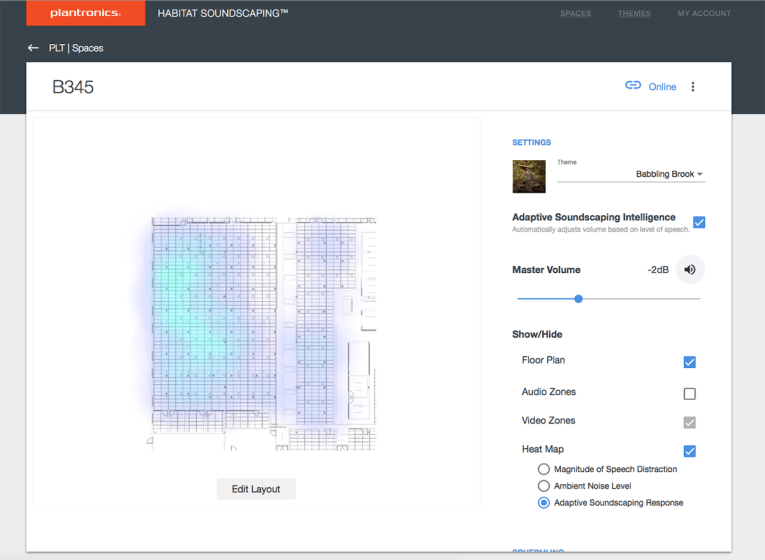
Cloud-Based Subscription Service
Plantronics offers a cloud-based subscription service, at one-year, three-year and five-year increments. The service provides access to Adaptive Soundscaping intelligence to dynamically optimize the open office environment by adjusting to changing conversation levels. Access to data insights using acoustic heat maps and automatic health checks, which ensure Habitat Soundscaping is operating efficiently. Subscribers also receive a library of Habitat Soundscaping audio content and a selection of digital window and digital skylight scenes.
Putting Habitat Soundscaping to the Test
In August and September 2017, we tested the Habitat Soundscaping solution at Plantronics offices in Hoofddorp, near Amsterdam, Netherlands. Our goal was to understand the system’s efficacy in reducing speech intelligibility in an open office and how employees would accept it. The biophilic soundscape was tested against a control (no distributed audio) and against two other sound files using a distributed audio system, both of which were filtered noise sound files.
What we were looking for was a reduction in Speech Transmission Index (STI) at workstations in the space and deriving the distraction distance from the results. We surveyed employees that used the space before and after installation of the system to understand their levels of acceptance.
The testing showed that Habitat Soundscaping was the most effective at reducing STI when compared to the filter noise sound files. Significant improvements to the distraction distance (rD), were measured when a biophilic soundscape was deployed. Our findings concluded that rD reduced from 59’ with biophilic sound off to 23’ with biophilic sound turned on.

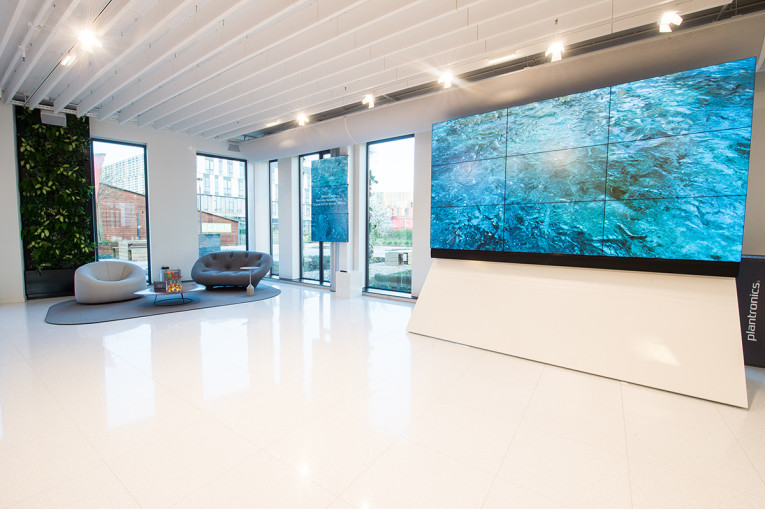
Going further, analysis of the employee responses shows that the biophilic soundscape system was rated (as an average) between 0.7 and 1.0 points better (on a scale of 1 to 5) than no distributed audio for three key acoustic environment and performance questions.
We took this employee satisfaction research a step further and engaged Leesman, a global firm that examines how workplaces affect employee and organizational performance. Leesman conducted research within our Hoofddorp office where the Habitat Soundscaping service is a core part of the office experience.
Leesman determines ranking using its Leesman Index, a global business intelligence tool which captures employee feedback on how effectively the workplace supports them. The Leesman Index measures a variety of factors including employee satisfaction around environmental features such as acoustics, temperature and natural light in the office (see Photo 7). The survey revealed that Plantronics employees agree that the ability to reduce noise is vital to creating an effective workplace, ranking it fourth among the most important office features.
Plantronics Hoofddorp office garnered the highest level ranking possible by Leesman, known as Leesman+, which is awarded to an elite group of workplaces that score 70 Lmi* or above on Leesman’s standardized performance scale. The score places the office in the top three Leesman+ buildings in Europe and makes it the highest scoring Leesman+ building in the Netherlands. Only 6% of all workplaces measured by Leesman have received the Leesman+ certification.
To learn more about biophilic science and Habitat Soundscaping, visit the company’s website at www.habitat.plantronics.com. aX
This article was originally published in audioXpress, August 2018.
Resources
“2017 North American Augmented Reality Technology Innovation Award,” https://habitat.plantronics.com/wp-content/uploads/2018/05/frost-sullivan-habitat-soundscaping.pdf, 2017.
Habitat Soundscaping, Plantronics,
https://habitat.plantronics.com
“The Global Impact of Biophilic Design in the Workplace,” Human Spaces, 2015, www.humanspaces.com.
“U.S. Workplace Survey 2016,” Gensler, 2016.
www.gensler.com/uploads/document/442/file/gensler_us_wps_2016.pdf.
“The Unmet Promises of the Open-Plan Office,” Oxford Economics, 2018, http://blog.oxfordeconomics.com/unmet-promises-of-the-open-plan-office.
“The Cost of Interrupted Work: More Speed and Stress,” Gloria Mark, University of California, Irvine; Daniela Gudith and Ulrich Klocke, Humboldt University, Berlin, Germany,
https:// www.ics.uci.edu/~gmark/chi08-mark.pdf, 2008.
About the Author
Robert Manassero is the Global Product Marketing Manager at Plantronics and currently leads the innovations marketing team. In this role, Manassero is responsible for bringing new business models to market and all associated marketing efforts. Manassero is a workplace technology and Unified Communications and Collaboration subject matter expert with a deep understanding in biophilic design and office acoustics. Manassero is a graduate from the University of Pacific and holds a Masters degree from San Jose State University.


